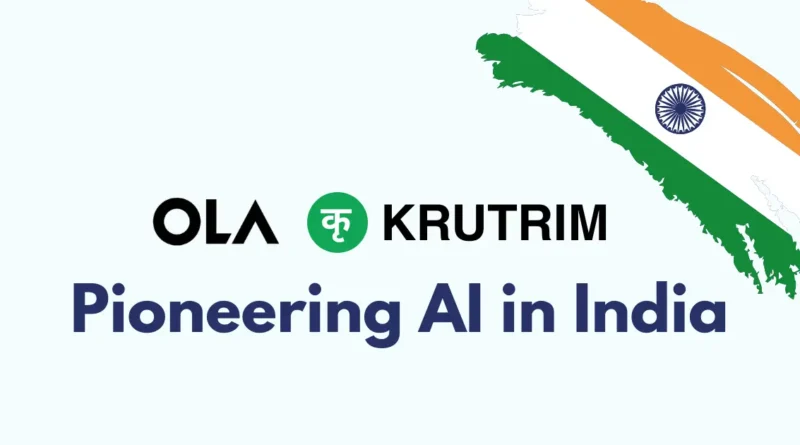Ola Krutrim: Pioneering India’s Own AI for a Brighter Future
Table of Contents
Introduction to Ola Krutrim
Ola Krutrim is an ambitious venture by Ola, the Indian multinational ridesharing company, spearheaded by its founder Bhavish Aggarwal. Launched with the vision of creating an indigenous AI ecosystem, Krutrim aims to be “India’s own AI.” This project encompasses a broad spectrum of AI technologies, from personal AI assistants to cloud services for enterprises, all tailored to meet the unique demands of the Indian market.
What is Ola Krutrim?
Ola Krutrim is a proprietary large language model (LLM) made by Ola, a major ride-hailing and technology company based in India. Unlike most AI language models available today, Ola Krutrim has unique capabilities. Its primary function is to understand and generate natural, fluid text in 22 Indian languages, including English and various regional languages (such as Marathi, Hindi, Bengali, Tamil, etc.). With Ola AI, users can interact with various AI-driven applications, services, and products, fostering a more inclusive and culturally resonant AI landscape in India.
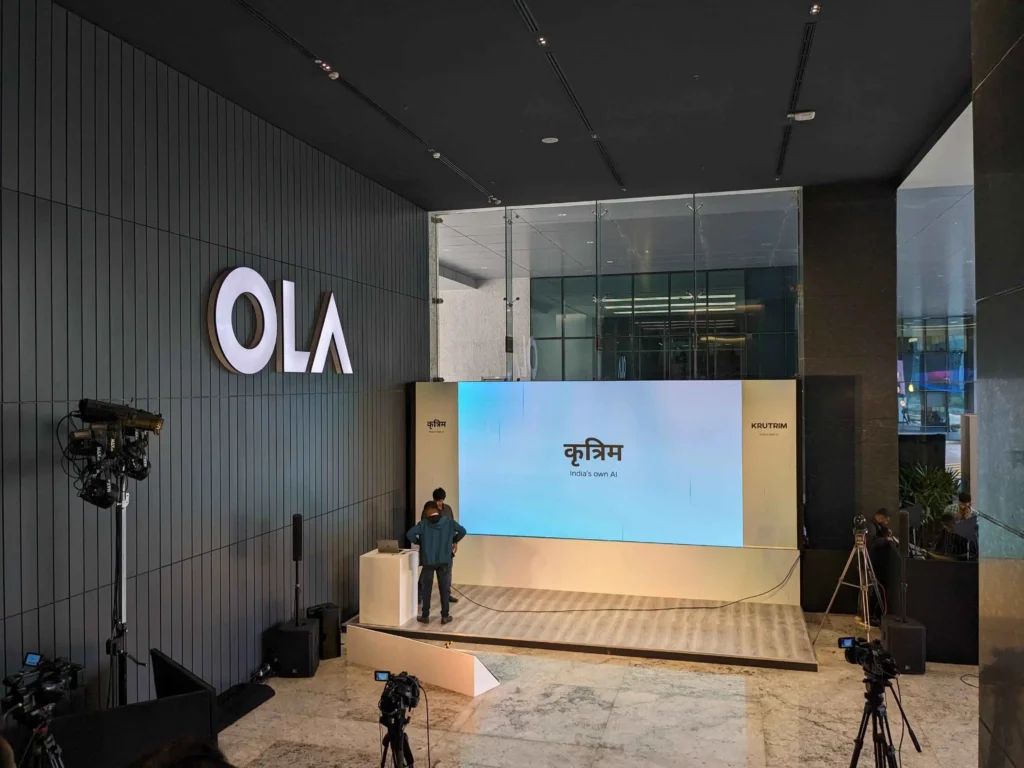
What Makes Ola Krutrim Unique?
- Cultural Relevance: One of Krutrim’s standout features is its deep integration with Indian culture. It understands over 22 Indian languages and can generate text in at least 10 of them, including Hindi, Tamil, Telugu, and Marathi. This linguistic diversity makes it uniquely positioned to serve a multilingual population like India’s.
- AI Cloud Services: Krutrim offers cloud infrastructure optimized for AI workloads. This includes scalable GPU solutions for AI training and inference, which are cost-effective and designed to reduce dependency on Western cloud platforms. The cloud service aims to provide a platform where enterprises, developers, and researchers can build and deploy AI applications more efficiently.
- First Generation AI Chatbot: Krutrim’s AI chatbot, accessible via chat.olakrutrim.com, is designed to assist users in personal and professional tasks. It offers functionalities like email drafting, information retrieval, skill learning, travel planning, and recipe suggestions. However, as a first-generation product, it’s acknowledged to have some “hallucinations” or inaccuracies, which Ola is actively working to improve.
- AI Chips – Krutrim Silicon: Perhaps one of the most audacious steps is the development of India’s first domestically designed and manufactured AI chips. Named Krutrim Silicon, these chips are aimed at accelerating AI and computing applications with high performance and energy efficiency. This move not only supports AI development but also aims at reducing India’s reliance on foreign semiconductor technology.
- Community and Developer Engagement: Krutrim has also ventured into fostering a community of developers through platforms like GitHub, where sample applications like iOS integration with Ola Maps SDK are shared. This encourages innovation and customization, tailored for Indian developers and use cases.
Applications and Impact
- Personal Use: For individuals, Krutrim acts as a personal assistant, simplifying daily tasks with a cultural touch. It’s seen as a tool that can bridge the digital divide by being accessible in multiple Indian languages.
- Enterprise Use: On the enterprise level, Krutrim’s cloud services and AI models aim to reduce development time and costs. By offering pre-trained models and a platform for model customization, it’s poised to help businesses integrate AI more seamlessly into their operations.
- Broad Societal Impact: Beyond immediate applications, Krutrim has the potential to influence education, healthcare, and other sectors by providing localized AI solutions. It could play a significant role in India’s digital transformation, supporting initiatives like “JanAI,” which could be likened to revolutionary projects like Aadhar or UPI.
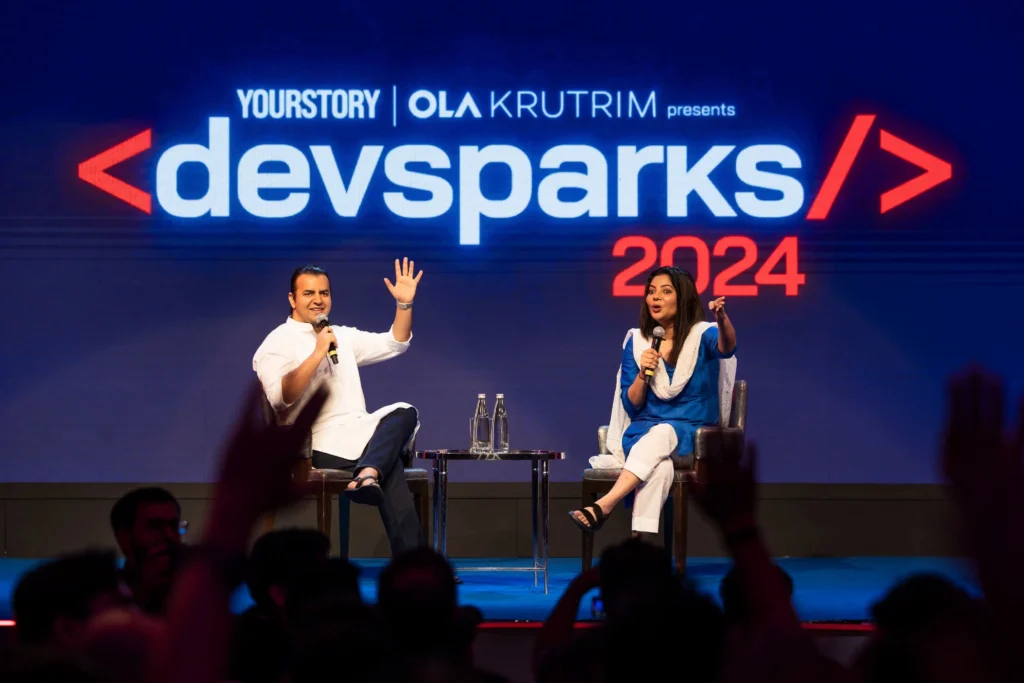
Challenges and the Road Ahead
- Accuracy and Reliability: As with any AI, ensuring the accuracy of information provided by Krutrim’s chatbot remains challenging. The acknowledgement of “hallucinations” suggests a focus on continuous improvement.
- Market Penetration: Competing with established giants like ChatGPT and Google’s Bard, Krutrim needs to carve out its niche through technology and user trust and adoption.
- Scalability and Infrastructure: While the initiative to build local AI infrastructure is commendable, scaling this to meet the demands of India’s vast and diverse market will be a significant challenge.
- Innovation in AI Chips: The development of Krutrim Silicon chips is groundbreaking, but their widespread adoption will depend on proving their efficiency, cost-effectiveness, and scalability against global standards.
Historical Development
Several key milestones mark Ola Krutrim’s journey. Initially launched as a research program aimed at creating an AI model that could integrate seamlessly with India’s linguistic diversity, its development involved a team of top AI researchers and engineers. This cutting-edge AI model wasn’t just envisioned in software rooms but was backed with substantial investment in data centres and infrastructure to ensure its scalability and real-world applicability.
Initially, as news of its development and funding began to circulate, there was a palpable excitement within the AI community both globally and within India. The launch of Ola Krutrim marked a significant moment for India in the AI landscape, with many hoping it would lead to a new era of innovation utilizing Indian languages and cultural contexts.
Impact on India and Beyond
The introduction of Ola Krutrim has numerous potential implications for various sectors, from education and customer service to personalized content creation and more. As AI becomes more prevalent in everyday life, Ola Krutrim represents a step towards AI accessibility for all, breaking down language barriers to desktop or mobile interaction.
In a global context, Ola Krutrim’s success is likely to be closely watched. The model’s attention to India-specific languages could inspire new avenues for multicultural and multilingual AI integration in other countries, potentially prompting updates and innovations to existing AI models worldwide.
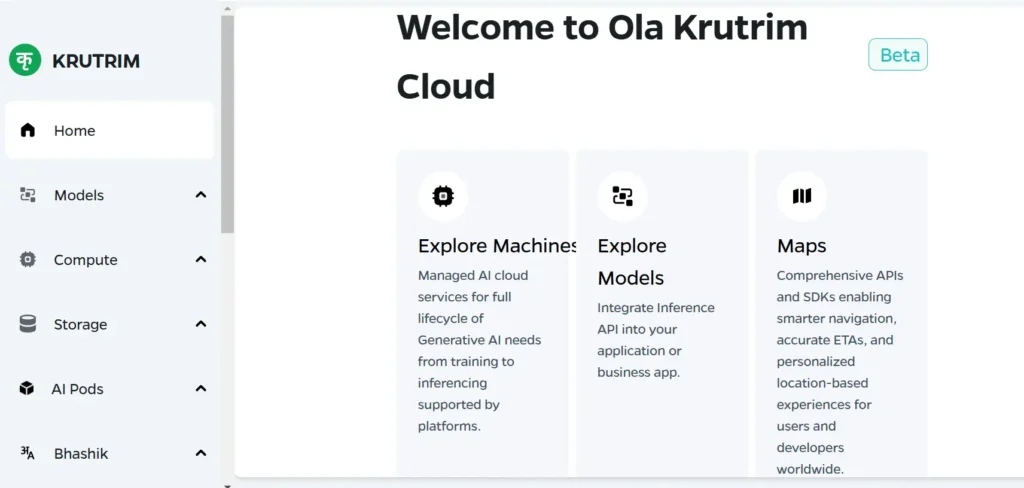
Encouraging Innovation and Benefiting Users
With Ola Krutrim, Bhavish Aggarwal and his team provide developers with tools to create a whole range of new AI-driven products and applications. Their goal is to provide a platform for startups and established firms alike to integrate AI technology into their offerings, enhancing user experiences and driving progress in sectors like e-commerce, telecommunications, entertainment, and many more.
For users, Ola Krutrim represents enhanced personalized services. Whether it be through smart home devices, mobile applications, or customer service chatbots, Ola Krutrim imbues technology with an understanding of the user’s language and context, making interactions with software more akin to talking with a knowledgeable friend. This rapport can lead to a more comfortable and efficient experience for those interacting with Bengaluru’s widely accessible AI technology.
Ethical Considerations and Vision for the Future
Ola Krutrim’s launch is not without its ethical concerns. Any large-scale AI integration prompts discussions on data privacy, AI bias, and ethical use of technology. While ensuring these aspects are addressed, the vision for Ola Krutrim remains focused on creating an AI ecosystem that supports social and economic progress, focusing on the values of precision, versatility, and security.
Towards a New AI Humanity in India
The use of Ola Krutrim as a tool for innovation and progress can herald a significant change in India’s technological and cultural landscape. While riding on the wave of its success, it’s important to remain cognizant of the potential challenges it will bring.
As India leaps forward into a future augmented by AI, Bhavish Aggarwal’s Ola Krutrim stands at the forefront, catalyzing the adoption of AI across the board and paving the way for emerging AI startups and technologies. From its creation using domestically designed AI chips to its integration into the daily lives of millions, Krutrim could well become the AI equivalent of the smartphone, transforming how Indians see and interact with the world through AI.
With a wide-ranging impact, Ola Krutrim strives to encourage innovation, foster inclusion, and elevate India’s socio-economic trajectory through the intelligent use and adaptation of AI. It marks its place in India’s march towards global superpower status while ensuring its adherence to ethical standards.
The time-lapse thus far is just the start of a multifaceted revolution Ola’s Krutrim could wield. The interplay between it and India’s burgeoning technology servitude could herald unprecedented milestones in innovation, reflecting the country’s strides towards linguistic and cognitively impactful AI dominance in the global arena.
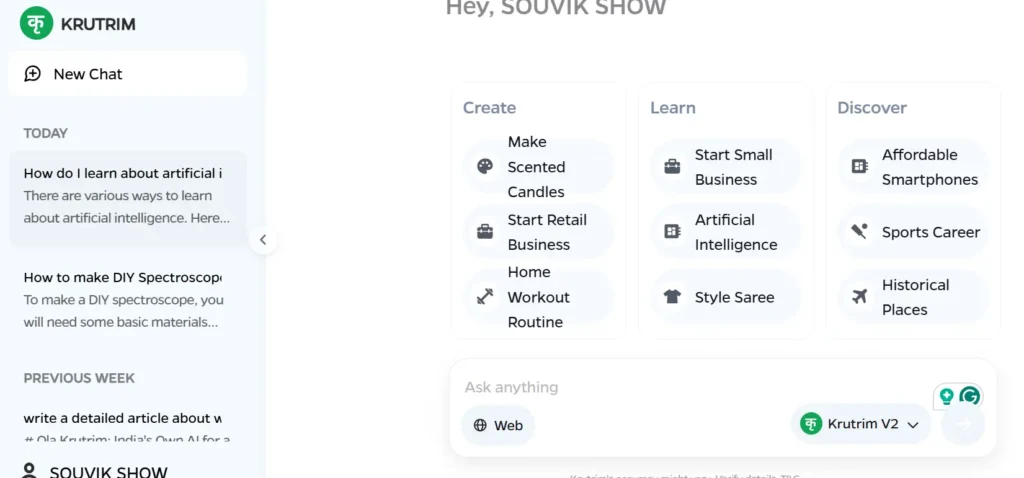
Is Ola Krutrim Comparable to ChatGPT or DeepSeek?
Ola Krutrim, India’s homegrown AI by Ola and Bhavish Aggarwal, is still developing but has unique strengths. It excels in understanding over 20 Indian languages and cultural contexts, claiming to outperform ChatGPT and GPT-4 in Indic benchmarks. It also offers AI cloud services, and chips (Krutrim Silicon), and has integrated DeepSeek models on Indian servers for cost-effective solutions.
However, it lags behind ChatGPT and DeepSeek in global versatility, technical precision, and reliability. ChatGPT is stronger in conversational fluency, creativity, and up-to-date global knowledge, while DeepSeek excels in technical tasks, efficiency, and cost (e.g., $0.14 per million tokens vs. ChatGPT’s $7.50). Krutrim has faced criticism for inaccuracies and is less mature, but its focus on India makes it a valuable local alternative.
In short, Krutrim is competitive in Indian contexts but not yet on par globally. It’s catching up by leveraging partnerships (like DeepSeek) and scaling infrastructure, but ChatGPT and DeepSeek currently lead in broader applications.
Conclusion
Ola Krutrim stands at the forefront of India’s AI revolution, not just as a technological leap but as a cultural and economic one. By focusing on India-specific solutions, it has the potential to redefine how AI is integrated into everyday life in one of the world’s largest markets. The journey of Krutrim from a beta version to a mainstream tool will be watched closely, as it could set a precedent for other countries to follow in customizing technology to fit their unique contexts.
With ongoing developments and a commitment to innovation, Ola Krutrim is not just an AI product but a vision for India’s technological self-reliance and advancement.
FAQs About Ola Krutrim
-
What is Ola Krutrim?
Ola Krutrim is an AI initiative by Ola, aimed at creating a comprehensive AI ecosystem tailored for India. It includes AI models, cloud services, and even India’s first AI chips, all designed to cater to the unique needs of the Indian market, focusing on language diversity and cultural relevance.
-
Who launched Krutrim?
Krutrim was launched by Bhavish Aggarwal, the founder and CEO of Ola, who has a vision to make India a leader in AI technology.
-
What languages does Krutrim support?
Krutrim’s AI models can understand over 20 Indian languages and generate content in at least 10, including Hindi, Tamil, Telugu, Marathi, Bengali, Kannada, Malayalam, Gujarati, Odia, and more, along with English.
-
What are the main components of Krutrim’s offerings?
AI Models: Including the base model Krutrim and a more advanced Krutrim Pro for multimodal capabilities.
AI Cloud Services: Providing infrastructure for AI development, with scalable GPU solutions for training and inference.
Krutrim Silicon: India’s first domestically designed AI chips for enhanced computing performance.
Ola Maps: An AI-driven mapping solution tailored for India’s unique geographical and traffic conditions. -
How can one access Krutrim’s services?
Users can access the Krutrim chatbot through chat.olakrutrim.com for personal use. For developers and businesses, APIs will be available for integrating Krutrim’s AI capabilities into their products or services.
-
What are the benefits of using Krutrim for businesses in India?
Cultural and Linguistic Fit: AI responses that resonate with local culture and language nuances.
Cost-Effective Solutions: With an India-first cost structure, reducing dependency on foreign cloud services.
Customization: Ability to tailor AI models for specific business needs.
Data Privacy: Utilizing domestic servers ensures data privacy and compliance with local laws. -
Can Krutrim outperform existing AI like ChatGPT or Google’s Bard in Indian contexts?
Krutrim is designed with a focus on Indian languages and cultural contexts, claiming to outperform models like GPT-4 in terms of Indic language support. However, its performance in English and other global benchmarks is still evolving, with an acknowledgement of “hallucinations” or inaccuracies in its early stages.
-
When will Krutrim Pro be available?
Krutrim Pro, a more advanced multimodal AI model, was slated for release in early 2024, focusing on enhanced problem-solving and task execution capabilities.
-
What is Krutrim’s approach to AI ethics and safety?
Krutrim incorporates the latest in safe AI techniques to reduce inappropriate responses. The focus is on creating AI that aligns with Indian values and ethics, though specific details on their ethical framework are less documented.
-
How is Krutrim contributing to India’s digital ecosystem?
Beyond AI models, Krutrim aims to build a complete AI computing stack in India, fostering local innovation, reducing the digital divide, and supporting India’s journey towards becoming an AI-first economy. This includes investments in supercomputing, AI infrastructure, and educational initiatives.
-
Is there any public feedback or critique on Krutrim?
Public feedback has been mixed. While the initiative has been praised for its ambition and cultural relevance, there have been critiques regarding the maturity of the AI models, occasional inaccuracies, and the need for further development to match global standards in some areas.

